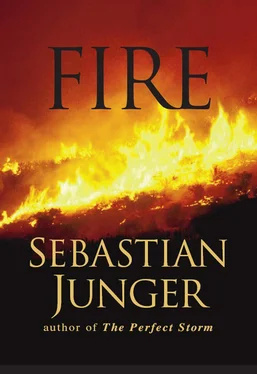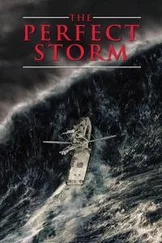According to Root, all over the West, fire conditions were about as dangerous as they could get. The drier the fuels, the hotter they burn and the faster the fires spread, and fuel moisture levels that should be at 15 or 20 percent are down in the single numbers. Low relative humidity and unstable air (wind) compound the problem. Fires are generally slow-moving creatures, moving a few chains an hour. But sometimes they can explode up a hillside or across a canyon, and the mountains all around us, scorched by seven years of drought, were as likely as they’d ever been to produce such behavior.
“I’ve never seen it so dry,” said Root, fingering the yellow cheatgrass around us. “One little ember in this stuff, and it ignites; last night every ember was taking. The fuels in Washington and Oregon are drier than what you’d buy at a lumber store. Now all it takes is one lightning strike in thousand-hour fuels for it to catch. That’s almost unheard of.”
Thousand-hour fuel is a piece of wood between three and eight inches thick. The thousand hours mean that if the fuel were completely saturated with water, it would take a thousand hours for it to lose 63 percent of its weight through evaporation. Conversely, if it were bone-dry, it would take a thousand hours to soak up 63 percent of its weight in moisture. Sixty-three percent is used as a benchmark because it is midway between two points—above 78 percent and below 58 percent—where moisture absorption or evaporation happens in a predictable, linear fashion. In that middle range, however, wood gains or loses moisture in a very complex way, and 63 percent is at the mathematical center point of that nonlinear range. Grass and twigs dry out or saturate almost immediately—one-hour fuels. Sagebrush and other small growth are considered ten-or hundred-hour fuels. Thousand and ten-thousand-hour fuels include everything else, up to ponderosa pine with six-foot diameters. It is very rare for thousand-hour fuels to be as dry as one-hour fuels, but they are. Everyone was worried. As one hotshot said, “There are no small fires anymore.” Everything that ignites tends to explode.
Fuel moisture levels can be established by field tests or by extrapolations based on information from the National Weather Service. The fuel moisture level is factored into an index that includes weather conditions, wind speeds, fuel loads (the total oven-dry weight, per acre, of all the fuels in the area), and drought conditions. The information is processed by the National Fire Rating System, which determines the fire risk for every climactic region in the country. It predicts such things as fire intensity, the likelihood of lightning strikes, and what is called the ignition component, the probability that a single firebrand landing in dry fuels will start a fire that requires a response. In addition, precise and highly accurate “spot” forecasts can be derived by the National Weather Service for areas as small as a quarter acre. A spot forecast may state that the temperature range for a specific canyon in the Boise National Forest will be between seventy-eight and eighty degrees; the humidity between 12 and 14 percent; and the winds ten miles an hour. Such information is crucial when ’shot crews are deployed in high-risk situations.
At the macro end of the spectrum is the general state of drought. In 1988 the whole country suffered through a brutally hot summer: Barges were running aground on the Mississippi River; railroad tracks were warping in New Jersey. The drought culminated in the fires at Yellowstone National Park. From late June until early November fires burned a total of 1.2 million acres across the West, more than half of which was in Yellowstone itself. On August 20 alone—Black Saturday—seventy-mile-per-hour winds fanned three-hundred-foot flames through a total of 165,000 acres. Although much of the country returned to normal that winter, the drought in the western states never really ended. Drought-stressed trees died by the thousands. Dry lightning storms continued to ignite huge fires. Fuel moisture contents dipped to 2 and 3 percent. The Palmer Drought Index—a water accounting system that measures water gained and lost in a given area—indicated that the entire West was entering the driest period since records had been kept in the 1870s. On the Palmer Drought Index, 0 is normal, +4 is extreme flooding, and-4 is extreme drought. During the summer of ’88 Yellowstone registered -5.8. During the Flicker Creek fire the National Weather Service declared the Boise area to have hit -6.5.
Out here that is not an abstract figure; it has the ability to stun. I repeated it to a division superintendent on another fire, and he jerked his head back as if he’d been slapped.
Root finished his last candy bar, and we both stood up. I thanked him for the talk. Helicopters thumped continuously overhead with the Bambi buckets, and ’shot crews raised plumes of dust on the steep hillsides. Casey angled slowly uphill toward me in the high August sun, and after he arrived, we contoured across the ridge and headed for the west side, where the Chief Mountain and Flathead ’shot crews were cutting snags and putting out spots above the river. Snags (standing dead trees) are routinely cut down whether they pose a fire threat or not; some are completely hollow inside and standing on a virtual toothpick. When they let go, it is without a sound, and occasionally there is someone standing underneath. At the Red Bench fire in 1988, a hotshot was killed by a snag while waiting for a bus by the side of the road. “Death comes from above,” one hotshot warned, explaining why he walked around with his head tilted up.
We stopped to talk for a while to the Flathead crew, two of whom had been at the infamous Dude fire in Arizona when a convict crew were burned over in their shelters. Melissa Wagner, now reclined in the cheatgrass eating lunch, recalled hearing the screams of the convicts over the radio as they died. One of the survivors left his fire shelter too early and emerged from the flames with his hair smoking and 47 percent of his body burned. Six others died. Wagner kept fire fighting because she needed a way to pay for law school.
Casey and I continued toward the Chief Mountain crew, visible on a distant ridgeline with smoke coming up behind them and helicopters circling above. Halfway there, trudging through the dust and baking heat, Casey suddenly jumped back and almost knocked me down. A big rattler was coiled on a rock in the middle of the fire line. It didn’t move, and it didn’t rattle; in fact, it was headless. We reached the Blackfeet crew twenty minutes later. They were sitting in the shade of a small ponderosa, eating their lunches; way downhill, a solitary tree was torching.
“So, you guys know anything about that rattler back there?” Casey asked.
There was silence. Every man in the crew looked off in a different direction.
“Rattler?” Glen Stillsmoking, the crew boss, finally said.
“Sons of bitches,” Casey muttered, shaking his head but with a smile.
We sat down in the shade to drink some water and take in the view. One of the crew pulled an obsidian arrowhead from his pocket; he said he’d found it at the helispot at Barber Flats. Stillsmoking leaned in to take a look. “We were a pretty hostile people,” he admitted, looking around at his crew. “We ran Chief Joseph off; we were the last to settle down. But now we make good fire fighters. My father was a fire boss; I wanted to go to flight school, but fire just drew me away. We’ve been to Alaska, Florida, paid vacations—that’s what we call work—everywhere. At the safety briefings in Florida they told us to watch out for the alligators.”
Downslope, a pair of sawyers—sawdogs, they’re called—were dropping snags; the sound of their Stihls reached us as a puny whine. A lone ponderosa burned lazily behind us a mile away, and the river glinted far below us in the canyon. This was probably as peaceful as it got on a fire line, and the crew didn’t seem in a particular hurry to ruin the moment. I leaned back and tried to stop wishing the fire would do something big.
Читать дальше












